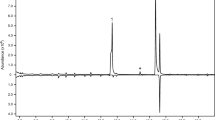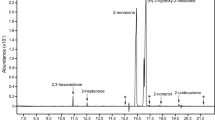Abstract
The bark beetles Pityogenes bidentatus and Pityogenes quadridens (Coleoptera, Curculionidae, Scolytinae) are sibling species that feed and reproduce in bark areas on branches of Scotch pine, Pinus sylvestris. To identify aggregation pheromone components of both species, hindguts and head/thoraxes of males and females of both species feeding in hosts were extracted in pentane and analyzed by gas chromatography and mass spectrometry. Hindguts of male P. bidentatus contained grandisol as the major component along with small amounts of (4S)-cis-verbenol and other monoterpenes. Dose–response bioassays in the laboratory showed the components were attractive at 0.2 ng/min to walking beetles from a distance of ≥25 cm. In the field in southern Sweden, grandisol and (4S)-cis-verbenol were weakly attractive alone when released at rates of 0.05 and 0.5 mg/day, respectively, from a slow-rotating trap pair. Catch increased 3.6- to 13-fold when the two components were released together. The male proportion of the catch was 0.8 early in the flight period, declined to 0.5 on the peak flight day, and then declined further during the next 2 weeks to 0.2 on the last day of the flight period. Hindguts of male P. quadridens contained (2S,5R)- and (2S,5S)-chalcogran, as well as (E)-2-(3,3-dimethylcyclohexylidene)ethanol (E-grandlure 2) and E/Z-mixture of 2-(3,3-dimethylcyclohexylidene)acetaldehyde (grandlures 3 and 4), while female hindguts had only a trace amount of chalcogran. Laboratory studies proved E-grandlure 2 is an essential pheromone component for P. quadridens. Field bioassays with a slow-rotating trap pair in which the attractiveness of blends containing various candidate components were compared with that of less complete mixtures, showed that chalcogran and E-grandlure 2 were synergistic aggregation pheromone components of P. quadridens. Field tests also showed that grandisol (from P. bidentatus) reduced attraction of P. quadridens to its aggregation pheromone, whereas E-grandlure 2 and chalcogran (from P. quadridens) reduced response of P. bidentatus to its aggregation pheromone. Our results suggest that aggregation pheromone components from males of each species not only attract conspecifics but also aid individuals in avoiding interspecific mating and competition for food and spatial resources within the bark phloem layer.






Similar content being viewed by others
References
Ambrogi BG, Palacio Cortés AM, Zarbin PHG (2012) Identification of male-produced aggregation pheromones of the curculionid beetle Sternechus subsignatus. J Chem Ecol 38:272–277
Anderbrant O, Schlyter F, Birgersson G (1985) Intraspecific competition affecting parents and offspring in the bark beetle Ips typographus. Oikos 45:89–98
Baader VEJ (1989) Pityogenes spp. (Col., Scolytidae): Untersuchungen über verhaltenssteuernde Duftstoffe und deren Anwendung im Waldschutz. J Appl Entomol 107:1–31
Bedoukian RH, Wolinsky J (1975) A biogenetic-type synthesis of the cyclohexyl constituents of the boll weevil pheromone. J Org Chem 40:2154–2156
Birch MC, Wood DL (1975) Mutual inhibition of the attractant pheromone response by two species of Ips (Coleoptera: Scolytidae). J Chem Ecol 1:101–113
Birch MC, Svihra P, Paine TD, Miller J (1980) Influence of chemically mediated behaviour on host tree colonization by four cohabiting species of bark beetles. J Chem Ecol 6:395–414
Birgersson G, Debarr GL, de Groot P, Dalusky MJ, Pierce HDP Jr, Borden JH, Meyer H, Francke W, Espelie KE, Berisford CW (1995) Pheromones in white pine cone beetle, Conophthorus coniperda (Schwarz) (Coleoptera: Scolytidae). J Chem Ecol 21:143–167
Birgersson G, Dalusky MJ, Berisford CW (2000) Identification of an aggregation pheromone for Pityogenes hopkinsi (Coleptera: Scolytidae). Can Entomol 132:951–963
Birgersson G, Dalusky MJ, Espelie KE, Berisford CW (2012) Pheromone production, attraction, and interspecific inhibition among four species of Ips bark beetles in the southwestern USA. Psyche Entomol J vol. 2012, ID 532652 p 14
Booth DC, Phillips TW, Claesson A, Silverstein RM, Lanier GN, West JR (1983) Aggregation pheromone components of two species of Pissodes weevils (Coleoptera: Curculionidae): Isolation, identification, and field activity. J Chem Ecol 9:1–12
Byers JA (1983) Sex-specific responses to aggregation pheromone: Regulation of colonization density in the bark beetle Ips paraconfusus. J Chem Ecol 9:129–142
Byers JA (1989) Chemical ecology of bark beetles. Experientia 45:271–283
Byers JA (1992) Optimal fractionation and bioassay plans for isolation of synergistic chemicals: the subtractive-combination method. J Chem Ecol 18:1603–1621
Byers JA (1993) Avoidance of competition by spruce bark beetles, Ips typographus and Pityogenes chalcographus. Experientia 49:272–275
Byers JA (2013) Modeling and regression analysis of semiochemical dose-response curves of insect antennal reception and behavior. J Chem Ecol (in press)
Byers JA, Wood DL (1980) Interspecific inhibition of the response of the bark beetles, Dendroctonus brevicomis and Ips paraconfusus, to their pheromones in the field. J Chem Ecol 6:149–164
Byers JA, Birgersson G, Löfqvist J, Bergström G (1988) Synergistic pheromones and monoterpenes enable aggregation and host recognition by a bark beetle, Pityogenes chalcographus. Naturwissenschaften 75:153–155
Byers JA, Högberg HE, Unelius CR, Birgersson G, Löfqvist J (1989) Structure-activity studies on aggregation pheromone components of Pityogenes chalcographus (Coleoptera: Scolytidae): All stereoisomers of chalcogran and methyl 2,4-decadienoate. J Chem Ecol 15:685–695
Byers JA, Birgersson G, Löfqvist J, Applegren M, Bergström G (1990a) Isolation of pheromone synergists of bark beetle, Pityogenes chalcographus, from complex insect-plant odors by fractionation and subtractive-combination bioassay. J Chem Ecol 16:861–876
Byers JA, Schlyter F, Birgersson G, Francke W (1990b) E-Myrcenol in Ips duplicatus: An aggregation pheromone component new for bark beetles. Experientia 46:1209–1211
Byers JA, Zhang QH, Schlyter F, Birgersson G (1998) Volatiles from nonhost birch trees inhibit pheromone response in spruce bark beetles. Naturwissenschaften 85:557–561
Byers JA, Zhang QH, Birgersson G (2000) Strategies of a bark beetle, Pityogenes bidentatus, in an olfactory landscape. Naturwissenschaften 87:503–507
Dickens JC, Mori K (1989) Receptor chirality and behavioral specificity of the boll weevil, Anthonomus grandis Boh. (Coleoptera: Curculionidae), for its pheromone; (+)-grandisol. J Chem Ecol 15:517–528
Eller FJ, Bartelt RJ, Baruch SS, Schuster DJ, Riley DG, Stansly PA, Müller TF, Shuler KD, Johnson B, Davis JH, Sutherland CA (1994) Aggregation pheromone for the pepper weevil Anthonomus eugenii Cano (Coleoptera: Curculionidae): Identification and field activity. J Chem Ecol 20:1537–1555
Francke W, Dettner K (2005) Chemical signalling in beetles. Top Curr Chem 240:85–166
Francke W, Heemann V, Gerken B, Renwick JAA, Vité JP (1977) 2-Ethyl-1,6-dioxaspiro[4.4]nonane, principal aggregation pheromone of Pityogenes chalcographus. (L.). Naturwissenschaften 64:590–591
Francke W, Pan M-L, König WA, Mori K, Paupoomchareon P, Heuer H, Vité JP (1987) Identification of ‘pityol’ and ‘grandisol’ as pheromone components of the bark beetle, Pityophthorus pityographus. Naturwissenschaften 74:343–345
Francke W, Bartels J, Meyer H, Schröder F, Kohnle U, Baader E, Vité JP (1995) Semiochemical from bark beetles: new results, remarks, and reflections. J Chem Ecol 21:1043–1063
Hedin PA, Dollar DA, Collins JK, Dubois JG, Mulder PG, Hedger GH, Smith MW, Eikenbary RD (1997) Identification of male pecan weevil pheromone. J Chem Ecol 23:965–977
Hibbard BE, Webster FX (1993) Enantiomeric composition of grandisol and grandisal produced by Pissodes strobi and P. nemorensis and their electroantennogram response to pure enantiomers. J Chem Ecol 19:2129–2141
Lekander B, Bejer-Peterson B, Kangas E, Bakke A (1977) The distribution of bark beetles in the Nordic countries. Acta Entomol Fenn 32:1–36
Nardi JB, Young AG, Ujhelyi E, Tittiger C, Lehane MJ, Blomquist GJ (2002) Specialization of midgut cells for synthesis of male isoprenoid pheromone components in two scolytid beetles, Dendroctonus jeffreyi and Ips pini”. Tissue Cell 34:221–231
Savoie A, Borden JH, Pierce HD Jr, Gries R, Gries G (1998) Aggregation pheromone of Pityogenes knechteli and semiochemical-based interactions with three other bark beetles. J Chem Ecol 24:321–337
Schlyter F, Byers JA, Löfqvist J (1987) Attraction to pheromone sources of different quantity, quality, and spacing: Density-regulation mechanisms in bark beetle Ips typographus. J Chem Ecol 13:1503–1523
Schurig V, Weber R (1984) Use of glass and fused–silica open tubular columns for the separation of structural, configurational and optical isomers by selective complexation gas chromatography. J Chromatogr 289:321–332
Spiegel MR (1961) Statistics. McGraw-Hill Book Co., New York
Taban AH, Fu J, Blake J, Awano A, Tittiger C, Blomquist GJ (2006) Site of pheromone biosynthesis and isolation of HMG-CoA reductase cDNA in the cotton boll weevil, Anthonomus grandis. Arch Insect Biochem Physiol 62:153–163
Tumlinson JH, Hardee DD, Gueldner RC, Thompson AC, Hedin PA, Minyard JP (1969) Sex pheromones produced by male boll weevil: Isolation, identification and synthesis. Science 166:1010–1012
Acknowledgments
The study was supported by grants from the Swedish Council for Forestry and Agricultural Research (SJFR) to the Swedish University of Agricultural Sciences, Alnarp, Sweden. Mention of trade names or commercial products in this article is solely for the purpose of providing specific information and does not imply recommendation or endorsement by the U. S. Department of Agriculture. USDA is an equal opportunity provider and employer.
Author information
Authors and Affiliations
Corresponding author
Additional information
Handling Editor: Thomas Schmitt.
Rights and permissions
About this article
Cite this article
Byers, J.A., Birgersson, G. & Francke, W. Aggregation pheromones of bark beetles, Pityogenes quadridens and P. bidentatus, colonizing Scotch pine: olfactory avoidance of interspecific mating and competition. Chemoecology 23, 251–261 (2013). https://doi.org/10.1007/s00049-013-0139-9
Received:
Accepted:
Published:
Issue Date:
DOI: https://doi.org/10.1007/s00049-013-0139-9




